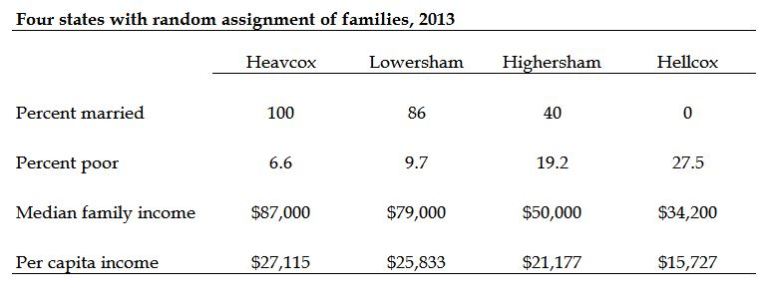I’m having a hard time believing the latest Brad Wilcox marriage-promotion fake research event is as dumb as I think it is, but I think it really is. I don’t use such a judgmental word lightly, but rather with a heavy heart, because it means it’s time to waste another hour debunking him.
The new thing is a report published by the American Enterprise Institute and “launched” at an event they hosted (droning-strike video here). The report is called, “Strong Families, Prosperous States” (PDF). The news coverage was light, which is a good sign for our news media, with credulous reports showing up in the Washington Post wonkblog and the Deseret News (though with Ross Douthat on the panel, expect more ripples sooner or later).
The basic finding is that people with more money are richer. But Wilcox (with co-authors anti-gay activist Joseph Price and Robert Lerman) describe it like this:
Higher levels of marriage, and especially higher levels of married-parent families, are strongly associated with more economic growth, more economic mobility, less child poverty, and higher median family income at the state level in the United States.
Their analysis, using state data over time, calculates the relationship between the change in marriage rates and the change in income per capita, poverty rates, and family income (mobility is done differently, using a single cross section, and I’m setting that aside for now). Basically, all this would be true if the only difference between states with lots of marriage and states with less marriage is that the former had more high income families — which of course they would, because married-couple families have higher incomes. So, rich people are richer.
To show how dumb this is, I illustrate it using fictional states made up of real families, drawn from the 2013 American Community Survey (data from IPUMS.org). I took all the married-couple and single-parent families with children, and created four states: Heavcox, where everyone is married; Hellcox, where no one is married; and two states in between, Lowersham (86% married) and Highersham (40% married). The families were assigned to states randomly (with replacement, so some families are in more than one state).
Here are the four states, with their scores on the measures used by Wilcox:
Heavcox has the lowest poverty, the highest median family income, and the highest per capita income (which means increase in marriage would lead to higher growth in per capita income).
The point is this has nothing to do with states, it’s composition: married-couple families more income, so their states do, too. The report includes a lot of statistical controls, but none that affect this basic pattern (for example, racial composition, average education level, and crime and tax rates). This is mostly because the units used for income and poverty are families. I’m not taking the time to do this, but I am pretty sure it would work if you randomly assigned individuals to families as well, that is, if the difference between married couples and single people was literally just the number of adults in the household. And with per capita income, more married-couple families means more high-income individuals, so higher income states. (Of course, there are interesting reasons married couples are richer, but they don’t have to do with states: they have more high-income earners, because high earners are more likely to get and stay married, and to a much lesser extent, because marriage helps people earn more.)
There is a funny note in the report, which says:
While these comparisons are based on median family income, we find similar gaps when we look at median household income or median household income adjusted for household size.
The adjustment for household size would help a little, but it still wouldn’t change the basic pattern, since married couple families have more earners, not just more people. But I completely distrust “we find similar…” if the numbers aren’t reported, since we know Wilcox lies a lot (frankly, even taking un-replicated numbers from one of his reports is dicey — I wouldn’t want to build a life raft out of it — but that’s the risk we take).
So, sure: “states show especially positive economic outcomes when a larger majority of their families are headed by married parents.” This is not news.
This is another case of think-tank public relations hype successfully masquerading as research, with journalists and funders as the intended audience. The American Enterprise Institute, which has a legal obligation to waste money, wants media mentions; reporters need easy stories expertly told and packaged for public consumption (unlike most real research); and political partisans want to click on and share things that support their assumptions. It is understandable that some honest reporters and editors fall for this stuff (and again, I’m appreciative of the many who didn’t). Washington Post reporter Jim Tankersley may have been trying to boost the legitimacy of the new report when he wrote this:
There is a story gaining steam among some academics that suggests the institution of marriage — particularly marriage for parents of young children — could play an important role in strengthening the American economy. It is a story about growth and poverty, about responsibility and work ethic.
But there is no evidence for the “gaining steam” thing in the story, except the existence of an American Enterprise Institute PR event.
Some reporters really try to check these stories out a little before running with them. But it’s hard for non-experts to do that, especially quickly. For example, Tankersley responded to a tweet I tweeted saying the report “appears to control for some of the factors you have raised flags about in the past.” Which is true, but this just shows the effectiveness of the PR, not the quality of the research. Which all means that as much as I don’t like the system we use to manage peer review, it’s still a good idea. There is nothing in this report that couldn’t have waited a few months for a real peer review before presenting it to the public.
If I’m wrong about this for some reason, and you can show my why — really show me, not just suggest other work I could do to check out your suspicions — I’ll be glad to admit it.
Aside: but why not?
You may be thinking, “sure, but isn’t it still the case that married couples are richer, so more people getting married would be good, right?” The first problem with that is that there is no known way to generate that outcome: the government’s marriage promotion has not worked at all, and I have seen no approach to trying that doesn’t impose religion or other values on people or shame them for their circumstances.
The second problem (which I wrote about a little here) is that the next marriage won’t bring the same benefits as the average existing marriage. If economics is one reason people don’t get married — and it is — then the economics of the currently-not-married will not be as beneficial as those experienced by the people who were in better shape to get married in the first place.



While I always read and enjoy your posts, Phil, the names of the fictional states took a special stroke of genius.
Congrats. Michael
Sent from my iPad
>
LikeLiked by 5 people
“Of course, there are interesting reasons married couples are richer, but they don’t have to do with states: they have more high-income earners, because high earners are more likely to get and stay married, and to a much lesser extent, because marriage helps people earn more.”
Is there not a bit more than this? More college graduates tend to become higher earners, AND tend to stay married; in addition, they tend to marry grads (with higher income). The assortative mating seems to be driven by cognitive ability. This assortative mating is driving inequality. In the marriage market, HS diploma holders and dropouts are viewed as failure, independent of their income.
Marriage does drive income, but not as BW says. However, you explanation of number of earners,which is meant to be a counter to BW, is not satisfactory either. A decoupling of college and income would rescue marriage.
LikeLike
I’d like to see the breakdowns for Enfield and Allston as well.
LikeLike